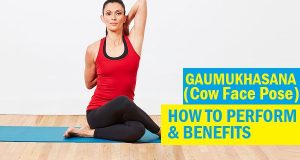
Vakrasana Or Twisted Pose Perform It for Multiple Health Benefits with Precautions
Vakrasana, also referred to as the Twisted Pose, is a yoga asana that involves a gentle twist of the spine. This pose is celebrated for its ability to provide a sense of relaxation while offering various physical and mental benefits. Vakrasana, also known as the Twisted Pose or Seated Twist Yoga Pose, is a flexible yoga twist that primarily focuses on twisting the spinal region. Despite its simplicity, Vakrasana offers substantial benefits by stretching and twisting the spinal cord and lower abdomen. This yoga pose is particularly suitable for beginners and provides a range of advantages for the body’s organs and overall well-being.
In this article, we will guide you through the proper steps to perform Vakrasana, explore its wide-ranging advantages, and provide crucial precautions to ensure a safe and effective practice.
How to Perform Vakrasana or Twisted Pose: Step-by-Step Instructions
Sit Upright: Begin by sitting on the floor with your legs stretched out in front of you. Keep your spine erect and your hands resting on your knees.
Bend One Knee: Bend your right knee and place your right foot flat on the floor beside your left knee.
Twist Towards Right: Inhale deeply and as you exhale, twist your torso towards the right, placing your left elbow on the outer side of your right knee.
Support Your Back: Press your left elbow against your right knee to deepen the twist gently. While doing so, place your right hand behind your back for that extra support.
Gaze Over Your Shoulder: Turn your head and neck to the right, looking over your right shoulder. Maintain a straight spine and a comfortable twist.
Hold and Breathe: Hold the pose for 20-30 seconds while breathing deeply. Feel the stretch along your spine.
Release and Repeat: Exhale as you release the twist, returning to the center. Repeat the same steps of this asana on the other side by bending your left knee and twisting to the left side. This completes one set of this asana.
Benefits of Vakrasana (Twisted Pose)
Incorporating Vakrasana into your yoga routine can provide these diverse benefits when practiced correctly and consistently. The benefits of Vakrasana, or the Twisted Pose, encompass various aspects of health and wellness. These advantages include:
Physical Benefits
Spinal Flexibility: Vakrasana enhances the flexibility of the spine, particularly the thoracic and lumbar regions.
Digestive Health: The twisting motion stimulates the abdominal organs, aiding in digestion and relieving constipation.
Improves Posture: Practicing this pose regularly can lead to improved posture by aligning the spine and promoting awareness of body alignment.
Back Pain Relief: Regular practice of Vakrasana can alleviate back pain, as well as headaches and neck pain.
Flexibility Enhancement: Vakrasana is an effective post-yoga pose that combats bodily stiffness and improves flexibility. Consistent practice is particularly beneficial for individuals with a stiff body.
Spine and Back Nerves: Vakrasana contributes to the health of spinal and back nerves. The twisting motion and compression provided by this pose promote extension and compression of the spine and back nerves, enhancing their condition and muscle health.
Lung Detoxification: The twisting and compression actions of Vakrasana facilitate the expulsion of stagnant blood from the spinal area. This blood is then directed towards the heart and lungs for purification. Consequently, lung capacity increases, and overall purification of bodily systems is promoted.
Minimization of Age-Related Issues: Vakrasana helps prevent the fusion of adjacent vertebrae, a common issue in older individuals.
Urinary System Benefits: Regular practice of Vakrasana ensures proper oxygen, blood, and nutrient flow to the urinary region, supporting a healthy urinary system and preventing urinary tract infections (UTIs).
Treatment of Slipped Discs: This yoga practice is helpful in managing mild cases of slipped discs and sciatica.
Diabetes Management: Vakrasana aids in managing diabetes by massaging abdominal organs, especially the pancreas. Stimulating the pancreas prompts increased insulin secretion, thereby controlling blood sugar levels. The pose also aids in addressing indigestion, constipation, and rheumatism.
Weight Loss: The pose involves significant twisting and compression in the abdominal region, which, when practiced regularly, aids in reducing belly fat and love handles.
Enhanced Blood Circulation: The compression and stretching actions associated with the abdominal organs promote improved blood circulation and nerve toning.
Stress and Strain Relief: Vakrasana is highly effective for individuals experiencing stress or strain in the back due to forward bending asanas.
Digestive Improvement: The twisting and compressing motions in the abdominal area stimulate the release of digestive juices, leading to improved digestion.
Headache Alleviation: By increasing blood circulation to the brain, Vakrasana aids in relieving headaches and refreshing the mind.
Mental Benefits
Enhanced Focus: The mindful engagement required during the pose enhances mental focus and concentration.
Calms the Mind: The combination of twisting and deep breathing can have a calming effect on the mind, promoting mental clarity.
Stress Relief: The gentle twist and deep breathing in Vakrasana promote relaxation, reducing stress and anxiety.
Precautions for Practicing Vakrasana (Twisted Pose)
Avoid Overexertion: While the Twisted Pose is beneficial, avoid forcing the twist or straining your muscles.
Injury or Pain: If you have a history of spinal injuries, hernias, or recent abdominal surgeries, consult a yoga instructor or healthcare professional before attempting Vakrasana.
Gentle Twist: Focus on a gentle twist that respects your body’s limitations. Do not push beyond your comfortable range of motion.
Avoid Jerky Movements: Perform the twist smoothly and gradually without jerking or sudden movements to prevent injury.
Vakrasana, the Twisted Pose, is a graceful yoga posture that offers both physical and mental benefits. By practicing this pose with proper alignment and mindfulness, you can enjoy improved spinal flexibility, digestive health, and reduced stress levels. Remember to approach the pose with caution, adhere to precautions, and respect your body’s signals. With regular practice and attention to detail, Vakrasana can contribute to your overall well-being.
FAQs About Vakrasana (Twisted Pose)
Is Vakrasana suitable for beginners?
Yes, beginners can practice Vakrasana with proper guidance. Start with a gentle twist and gradually deepen the pose over time.
Can Vakrasana be practiced during pregnancy?
It’s advisable to avoid deep twists like Vakrasana during pregnancy. Instead, consult a healthcare provider and focus on poses suitable for prenatal yoga.
Can Vakrasana alleviate lower back pain?
Yes, Vakrasana’s gentle twist can help relieve mild lower back discomfort by promoting spinal flexibility and proper alignment.
How long should I hold Vakrasana on each side?
Aim to hold the pose for 20-30 seconds on each side, ensuring a balanced stretch for both sides of the spine.
Can Vakrasana be practiced on a full stomach?
No, it’s recommended to practice Vakrasana on an empty stomach to avoid discomfort and ensure ease of movement during the twist.
 Tips and Beauty Site about Skin care, Hair care, Health, weight loss and lifestyle tips
Tips and Beauty Site about Skin care, Hair care, Health, weight loss and lifestyle tips






